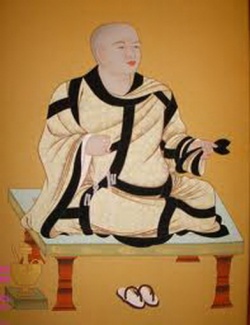Difference between revisions of "Vajrabodhi"
(Created page with "thumb|250px| Vajrabodhi (Ch.金剛智) (671–741) was an Indian buddhist monk and Esoteric Buddhist teacher in Tang China. He is one the eight pa...") |
|||
| Line 1: | Line 1: | ||
[[File:Vajrabodhi00.jpg|thumb|250px|]] | [[File:Vajrabodhi00.jpg|thumb|250px|]] | ||
| − | Vajrabodhi (Ch.金剛智) (671–741) was an Indian | + | Vajrabodhi (Ch.金剛智) (671–741) was an Indian [[Buddhist monk]] and Esoteric Buddhist teacher in Tang China. He is one the eight patriarchs in [[Shingon]] [[Buddhism]]. |
| − | Vajrabodhi was the second of three Vajrayana missionaries to eighth-century China. He was born of a South Indian brahmin family, and his father was a priest for the royal house. Vajrabodhi probably converted to Buddhism at the age of sixteen, although some accounts place him at the Buddhist institution of Nālandā at the age of ten. | + | Vajrabodhi was the second of three [[Vajrayana]] missionaries to eighth-century China. He was born of a South Indian [[brahmin]] family, and his father was a priest for the royal house. Vajrabodhi probably converted to [[Buddhism]] at the age of sixteen, although some accounts place him at the Buddhist institution of [[Nālandā]] at the age of ten. |
| − | He studied all varieties of Buddhism and was said to have studied for a time under the famous Buddhist logician Dharmakīrti. Under Santijnana, Vajrabodhi studied Vajrayāna teachings and was duly initiated into yoga. | + | He studied all varieties of [[Buddhism]] and was said to have studied for a time under the famous Buddhist logician Dharmakīrti. Under Santijnana, Vajrabodhi studied Vajrayāna teachings and was duly initiated into yoga. |
| − | Leaving India, Vajrabodhi traveled to Sri Lanka and Srivijaya (present-day Sumatra), where he apparently was taught a Vajrayāna tradition distinct from that taught at Nālandā. From Srivijaya he sailed to China via the escort of thirty-five Persian merchant-vessels, | + | Leaving [[India]], Vajrabodhi traveled to Sri Lanka and Srivijaya (present-day Sumatra), where he apparently was taught a [[Vajrayāna]] tradition distinct from that taught at Nālandā. From Srivijaya he sailed to China via the escort of thirty-five Persian merchant-vessels, and by AD 720 was ensconced in the Jianfu Temple at the Chinese capital, Chang'an (present-day Xian). Accompanying him was his soon-to-be-famous [[Disciple]], [[Amoghavajra]]. |
| − | Like Subhakarasimha, who preceded him by four years, Vajrabodhi spent most of his time in | + | Like [[Subhakarasimha]], who preceded him by four years, Vajrabodhi spent most of his time in [[Ritual]] activity, in translating texts from [[Sanskrit]] to Chinese, and in the production of [[Esoteric]] [[Art]]. Particularly important was his partial translation of the [[Sarvatathāgatatattvasagraha]] between the years 723 and 724. This [[Yoga Tantra]]- along with the Mahā[[Vairocana]] [[Sutra]]; translated by [[Subhakarasinha]] the same year- provides the foundation of the [[Zhenyan]] school in China and the Shingon and Esoteric branch of the Tendai school in [[Japan]]. Like Subhakarasinha, Vajrabodhi had ties to high court circles and enjoyed the patronage of imperial princesses; he also taught Korean [[Monk]] Hyecho; who went on to travel [[India]]. Vajrabodhi died in 732 and was buried south of the [[Longmen Grottoes]]. He was posthumously awarded the title [[Guoshi]], 'Teacher of the Realm'. |
{{W}} | {{W}} | ||
[[Category:Buddhist Terms]] | [[Category:Buddhist Terms]] | ||
[[Category:Chinese Buddhism]] | [[Category:Chinese Buddhism]] | ||
[[Category:Shin Buddhism]] | [[Category:Shin Buddhism]] | ||
Revision as of 21:41, 24 April 2013
Vajrabodhi (Ch.金剛智) (671–741) was an Indian Buddhist monk and Esoteric Buddhist teacher in Tang China. He is one the eight patriarchs in Shingon Buddhism.
Vajrabodhi was the second of three Vajrayana missionaries to eighth-century China. He was born of a South Indian brahmin family, and his father was a priest for the royal house. Vajrabodhi probably converted to Buddhism at the age of sixteen, although some accounts place him at the Buddhist institution of Nālandā at the age of ten.
He studied all varieties of Buddhism and was said to have studied for a time under the famous Buddhist logician Dharmakīrti. Under Santijnana, Vajrabodhi studied Vajrayāna teachings and was duly initiated into yoga.
Leaving India, Vajrabodhi traveled to Sri Lanka and Srivijaya (present-day Sumatra), where he apparently was taught a Vajrayāna tradition distinct from that taught at Nālandā. From Srivijaya he sailed to China via the escort of thirty-five Persian merchant-vessels, and by AD 720 was ensconced in the Jianfu Temple at the Chinese capital, Chang'an (present-day Xian). Accompanying him was his soon-to-be-famous Disciple, Amoghavajra.
Like Subhakarasimha, who preceded him by four years, Vajrabodhi spent most of his time in Ritual activity, in translating texts from Sanskrit to Chinese, and in the production of Esoteric Art. Particularly important was his partial translation of the Sarvatathāgatatattvasagraha between the years 723 and 724. This Yoga Tantra- along with the MahāVairocana Sutra; translated by Subhakarasinha the same year- provides the foundation of the Zhenyan school in China and the Shingon and Esoteric branch of the Tendai school in Japan. Like Subhakarasinha, Vajrabodhi had ties to high court circles and enjoyed the patronage of imperial princesses; he also taught Korean Monk Hyecho; who went on to travel India. Vajrabodhi died in 732 and was buried south of the Longmen Grottoes. He was posthumously awarded the title Guoshi, 'Teacher of the Realm'.
